
Bathroom Grab Bars
Product Guide and Recommendations
Bathroom grab bars make one of the most dangerous movements that the elderly make - stepping into and out of the bathtub - safer.
Seniors standing on one leg can be dangerous at the best of times, but particularly when having to stand on one leg while raising the other leg up and over a high tub wall - wow!
Getting into and out of the shower is not quite as risky but still comes with hazards for getting off balance.
The elderly often have to stand on one leg while getting their other leg up and over a small (or big) lip or end up holding onto a moving surface (such as the swinging or sliding shower doors).
Bathroom grab bars are one of the bathroom safety products that I recommend the most for preventing falls and you can see why.
If elderly people are having any difficulty with mobility or balance, grab bars are a must!
Who Should Use?
Seniors with any issues with mobility or balance would benefit from shower grab bars or bathtub grab bars.
Actually, I would say any elderly person would benefit from bathroom grab bars as a tool to prevent falls in this high risk area.
Who Should NOT Use?
There is no reason not to use bathroom grab bars.
They are great for improving safety and preventing falls.
They even come in a brushed metal that is quite nice looking and can compliment other bathroom decor.
Even the elderly who are not originally keen to get bathtub safety bars or shower handles end up finding them very handy.
Often a bathroom grab bar is put in for one person in a couple, but the spouse tells me later I always use it too!
Recommended Features
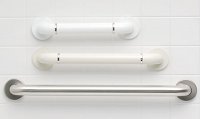
- Permanent (versus Non-Permanent)
When it comes to installing bathroom grab bars onto the walls of a shower or bathtub, I always recommend permanent installation.
There are suction cup grab bars, but I have heard of instances of the suction cup not sticking properly, which can cause a fall (the opposite of the purpose of the bathroom grab bar!).
If your landlord ABSOLUTELY will not allow the installation of a bathroom grab bar, then you could consider the suction cup grab bars as they may be better than nothing.
- Clamp-on Bathtub Safety Bar
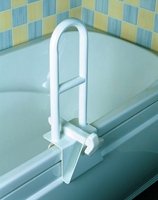
The one type of non-permanent bathroom grab bar that I recommend often is a clamp-on bathtub safety bar.
This type of bathroom grab bar is secured onto the side of the bathtub with a dial that clamps down securely onto rubber pads.
The grab bar extends up from the clamp (usually in a U-shape) and provides a stable surface to hold onto.
They can be purchased in a height adjustable version.
If they are tightened well, they are effective for holding onto when stepping into and out of the bathtub.
- Two stable surfaces
I always recommend that a person have two stable, sturdy surfaces to hold onto when stepping into and out of a bathtub or shower (ie. two grab bars).
I most prefer if the elderly person is able to reach both surfaces from outside the tub and can hold onto both prior to stepping into the tub. This is the most effective way to prevent falls.
- Non-slip surfaces
Try and find bathroom grab bars that have a non-slip surface as part of the grab bar. The metal types will have a "knurled" surface, a set of ridges to help with getting a firm grip.
Hardware stores often sell white powder-coated metal grab bars but these do not usually have a non-slip surface. A non-slip decal can be applied after the fact but isn't as good an option as getting bathtub safety bars with the non-slip surface already built in.
- Check Weight Capacity
Most bathroom safety equipment comes with a weight capacity. Be sure to check this for your loved one's weight.
- Qualified Healthcare Professional Recommendation
Having a qualified healthcare professional, such as an occupational therapist, recommend the proper set up for your aging parent's bathroom grab bars is the best way to ensure the bathroom is as safe as possible.
Not only will the healthcare professional be able to recommend the safest set-up, they can often also help with organizing and checking the installation of the grab bars if you prefer.
Types and Sizes
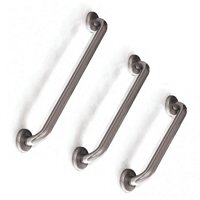
Types:
Bathroom grab bars generally come in metal and plastic, or a combination of the two.
The most common metal types for the medical grade bathroom grab bars are stainless steel or nickel. They also come in other metals such as chrome or brass.
Often the bathroom grab bar purchased at a hardware store is white powder-coated stainless steel.
Metal clamp-on bathtub safety bars are also usually this type.
Clamp-on bathtub safety bars will also come in plastic as will the suction cup bathroom grab bars.
Some suction bathroom grab bars and clamp-on safety bars will be a combination of plastic and white powder-coated steel.
Sizes and Shapes:
Bathroom grab bars come in many different shapes and sizes.
The most typical sizes for straight grab bars are 12", 16", 18", 24" and 32".
Once in a while, a 48 grab bar might be installed but this is rare.
Bathroom grab bars can also be angled or L-shaped.
How to Fit
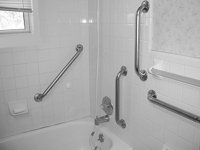
1) Use the recommendation of a qualified healthcare professional (when possible):
As every person has a different bathroom set up, having the recommendation of a qualified health care professional such as an occupational therapist can be vital.
2) Pay a medical supplier to install:
I always recommend that people pay to have a medical supplier install their grab bars.
At times, a family member feels handy enough to install the grab bars themselves.
This is a good option if they do indeed know what they are doing. However, you'd hate for any water to seep in behind your grab bar and rot out your bathtub or shower.
3) How grab bars are installed if no stud is available:
It is great if you can match up the best bathroom grab bar placement with a stud behind the wall.
However, this isn't always the case. It is more important to get the grab bar in the right place than to hit a stud.
Toggle bolts can be used on both fibreglass or ceramic bathtub or shower surrounds.
These are bolts with a butterfly on the end that can be put through the drill opening, the butterfly will open once through the drill hole and provide a secure surface to drill the grab bar into.
Lots of silicone is needed to ensure that the site is waterproof.
I have seen many grab bars done this way. If installed properly, they are very secure and there is no leaking.
4) Bathtub grab bar recommended placement:
As mentioned above, a proper recommendation of bathtub grab bar placement is difficult (almost impossible) without a proper bathroom assessment.
However, the most typical recommendation that I make for bathrooms with a bathtub is as follows:
- 24 vertical (up and down) grab bar at the entrance of the bathtub on the side opposite to the taps
- 24-32 grab bar angled at 45 degrees with the top closest to the taps and the bottom closest to the vertical grab bar above
- This works well for people that still get down into the tub to bathe, the trick is to make the bottom of the grab bar low enough for them to use it to help getting up from the tub while the top is high enough they can use it as a second stable surface to hang onto when getting into the tub (a 48 grab bar might be needed in this case)
- Another idea for bathers is to do it as above and also add a clamp-on bathtub safety bar at the end near the taps. This way they can hold onto the vertical grab bar and the clamp-on grab bar when getting into and out of the shower and can use the angled bar and the clamp-on bathtub safety bar when getting up from the bottom of the bathtub.
5) Shower grab bars recommended placement:
As mentioned above, a proper recommendation of the placement of shower grab bars is difficult (almost impossible) without a proper bathroom assessment.
However, my main goal in recommending shower grab bars is to provide two stable shower handles for the person to hold onto while getting into or out of the shower.
The most typical recommendation that I make for bathrooms with a small shower is as follows:
- 24 vertical (up and down) shower grab bar on the opposite side of the door hinges right at the entrance to the shower
- 24 vertical shower handle on the far wall of the shower (if it is close enough to reach before getting into the shower so you can hold two stable surfaces)
- Sometimes you might place this one closer or farther away along the wall if you will be using shower stools and will also be using it to get up and down from your shower stool
As I've said, it really is nearly impossible to make an appropriate recommendation without properly assessing the bathroom space, but this will give you some idea.
6) Size:
The size of bathroom grab bars can vary in both diameter and length (as discussed above).
Consider the size of the senior's hands when thinking of diameter.
Some of the nickel grab bars I've seen are quite nice looking but the diameter is larger and won't work for some tiny elderly lady hands.
On the other hand, some of the smaller grab bars make it difficult for big man hands to get a proper grip either.
7) Toilet:
Bathroom grab bars can also be placed beside the toilet for a hand hold when getting up and down.
The simplest grab bar is a 12-18" bar at a 45 degree angle on the wall beside the toilet (the bottom closest to the toilet and the top farthest away from the toilet).
Angled or L-shaped grab bars can also be very handy for beside the toilet.
How to Use
Bathtub grab bars or shower grab bars are used to provide a stable surface to hold onto when in an unbalanced position (ie. standing on one foot when moving into or out of the bath or shower).
The best set up is to have two stable surfaces within reach at all times when you will have one foot off the floor.
Travel:
If you are travelling, and need grab bars that are portable, there are two options:
- suction cup grab bars that can be put on and taken off easily
- clamp-on bathtub safety bars can also be portable
How Much Do They Cost?
A nice metal grab bar with a knurled surface usually costs between around $25-30 for a 12" to $38 - 45 for a 36".
Installation costs vary depending on the charge of the installer. Medical suppliers generally charge anywhere from $60 - $90/ hour to install. Installing two grab bars with reinforcers typically takes around 0.5 - 1 hour. Sometimes medical suppliers will charge per bathroom grab bar and the charge will be around $35 for the first grab bar and $15 for each additional grab bar.
Clamp-on bathtub safety bars are usually between $45 and $70 for the white powder-coated metal type or $60 - 85 for plastic.
Suction cup grab bars usually run between $25 - $50 depending on size though I do not recommend these unless you have no other options or are travelling and require a portable option.
A note that many of the suction cup grab bars come with a limited warranty while the metal, permanently installed grab bars usually come with a lifetime warranty.
Return to Bathroom Products for the Elderly
Return to Equipment for Seniors
Return to Caring for Aging Parents


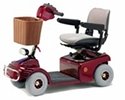



New! Comments
Have your say about what you just read! Leave me a comment in the box below.